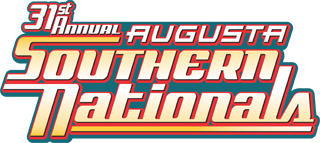About Drag Boat Racing • Drag Boat Classes • Drag Boat Safety • Talk The Talk Drag Boat Lingo
Basics
The basics of drag boat racing are very similar to those of land drag racing. It is an acceleration race over a measured quarter mile straightaway on water between two high performance race boats. However, drag boats us a slight moving start. This starting system was implemented as a safety precaution because it is difficult for a boat driver to determine if the boat will launch straight from a standing start.
As two boats are “paired up” on the holding rope, a countdown clock begins before the boats get the green light. During competition, if either boat crosses the starting line before the green light is illuminated, it is disqualified.
Each boat is allowed to qualify for eliminations by making at least one quarter-mile timed run. Each of the boats is clocked for an elapsed time (ET) that is determined from the time it takes the boat to cover the quarter-mile race from start to finish. Drag boats qualify on Saturday for a two-day event and on Friday and Saturday for three day events. Only the top qualifying boats will compete in the championship elimination rounds. The winner of each round of racing advances to the next round until only one boat remains as the class winner.
Mechanics
Take a walk through the pits for a closer look at the equipment that makes drag boat racing unique. Consider different hull designs and propulsion methods, there are three basic boat types: hydroplanes, flat bottom and jets, each with a variety of styles.
The Hydroplane drag boat uses a three point hull design to trap air. During acceleration, the hydro rides mainly on a cushion of air, with only its propeller and two rear edges of its sponsons (large torpedo-shaped pods on the sides of the hull that form a tunnel similar to pontoons on a catamaran) touching the water.
Flat Bottom drag boats cannot be designed with a tunnel bottom, although a modification called a “runner bottom” is now accepted. The flat bottom resembles a family ski boat in design; in fact, many drag boats retire to become ski boats.
A Jet drag boat can have any hull design, but differs from other drag boats types by the jet pump, which is its sole means of propulsion and steering.
Mentally take the driver’s seat in a racing flat bottom. At your feet are three pedals: on your right is the throttle and on your left, two petals that control the altitude of the bow with metal cavitation plates across the back of the boat. The motor’s 1600 to 4500 HP can provide enough torque to rotate the boat around the shaft. Skillful control of the cavitation plates keeps the boat from flipping. You can stage the boats to greater and greater speeds with the foot pedals controlling the throttle and cavitation.
Though the flat bottom and hydroplane can use the same motor, the tunnel hull makes driving completely different. Staging is not necessary with this wider, more stable hull type, but the boat must line up correctly at the starting line. Because the rudder is not functional at any speed, the boat simply goes where it is pointed. The hydroplane pilot can control the boat only with the throttle. Hydroplanes can reach speeds of 235 mph.
Drag boats do not use conventional Detroit-produced motors. In the beginning, racers converted salvaged Chrysler and Chevrolet motors. Today’s specialized cast aluminum racing motors include Keith black, Donovan and Arias, developed for drag racing.
In all professional classes except Competition Hydro, Flat bottom and Jet, motor have a size limit of 565 cubic inches (CI). Competition classes have a size limit of 470 CI and river racer classes a limit of 460 CI. The most common motor in the Blown Fuel class is a Keith Black, which is based on the Chrysler 392 CI Hemi-Head motor, a motor design from the 1950’s. The Donovan is also based on the Chrysler 392 CI Hemi, while the Arias, most commonly used in Blown Gas and Blown Alcohol classes, gets it’s design from the more current Chevrolet 454 block with a hemi-head adaptation from Chrysler. New, these motors can cost between $25,000 and $50,000.
Whether flat bottom, hydro or jet, the driver’s equipment is essentially the same. Each drive must wear a flameproof driving suit, crash helmet and goggles or face shield. A life jacket is also a must and a personal parachute is recommended for non-capsule-equipped boats. The parachute slows the driver down during a crash and pulls him away from the boat. Fuel and alcohol classes require flameproof boots, gloves and fuel masks.
Supercharged hydros also require drogue parachutes similar to those used with asphalt dragsters. These serve a dual purpose: they stop the boat from beaching beyond the finish line and keep it from crashing on power-down. Since the hydros travel on a cushion of air, a sudden reduction of power changes the aerodynamics dramatically. The parachute helps stabilize the boat tail and hull, keeping it under control.
For the protection of the drivers, officials and spectators, all boats, motors and driver’s equipment receive a careful technical inspection before event registration. Feel free to take a few minutes to visit the pits, talk with the crews and look at the sophisticated machinery and equipment that makes it all happen.
About Drag Boat Racing • Drag Boat Classes • Drag Boat Safety • Talk The Talk Drag Boat Lingo



